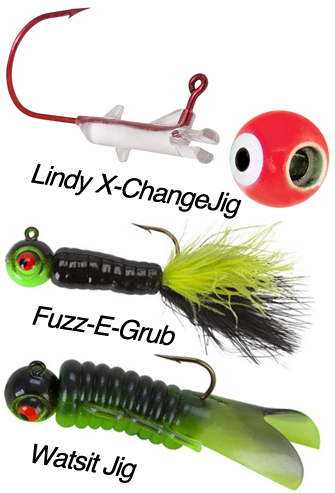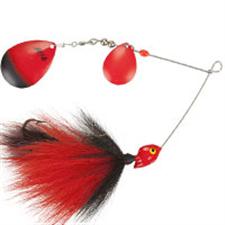 Long before Green Bay became synonymous with the Packers, the Bay of Green Bay, as the locals call it, was known for its superb fishing. A sub-basin of Lake Michigan, Green Bay is 120 miles long and ranges from 10 to 20 miles wide. This huge body of water offers ample opportunities to battle big walleye, northern pike, muskie and smallmouth bass. If you’re not familiar with Green Bay, the fastest way to get into the action is to hire a capable guide, such as Jason Muche.
Long before Green Bay became synonymous with the Packers, the Bay of Green Bay, as the locals call it, was known for its superb fishing. A sub-basin of Lake Michigan, Green Bay is 120 miles long and ranges from 10 to 20 miles wide. This huge body of water offers ample opportunities to battle big walleye, northern pike, muskie and smallmouth bass. If you’re not familiar with Green Bay, the fastest way to get into the action is to hire a capable guide, such as Jason Muche.
Should you choose to try your luck without a guide, you’d be wise to follow Muche’s invaluable advice for fishing Green Bay.
Walleye
The walleye is the big draw at Green Bay, and Muche runs more trips for this species than any other.
“June is a transition period for the walleye,” Muche says. “The water is warming and the walleye are moving out to mud flats in the bay.”
The lower 20 miles of Green Bay has the most productive flats, Muche claims.
On a typical day in June, Muche’s clients typically boat 15 to 20 walleyes that run 17 to 30 inches. He hosts two to three anglers at a time aboard his deep V-hull Triton 215X fiberglass walleye boat.
Muche’s bread-and-butter tactic is trolling Lindy Little Joe Walleye Spinner Rigs and No. 5 and No. 7 Lindy Shadling crankbaits behind in-line planer boards. He dotes on the Shadling because it always runs true out of the package with a tight wiggling action regardless of the trolling speed.
The Shadlings have lifelike holographic eyes and come in nine sublimely detailed baitfish hues. It’s easy to understand why these crankbaits trigger hard strikes.
Three trolling rods spooled with 10-pound monofilament line rest in rod holders on each side of Muche’s boat. The four rods closest to the transom are rigged with a Little Joe Walleye Spinner Rig that’s fixed to a 1-ounce, in-line chain sinker.
To cover different depth ranges, the spinners on one side of the boat are set 25 feet behind the board, while the spinners on the other side are set back 30 feet. If the walleyes show a preference for one side of the boat, all the rods are set for the productive depth.
The planers that swim farthest from the boat are attached to the two rods nearest the bow on opposite gunnels. A Lindy Shadling swims 90 feet behind each board with no weight. A GPS helps Muche maintain precise trolling speeds.
“I generally troll from 1.1 to 1.2 mph,” Muche says. “The morning bite tends to better, but we catch walleyes all day.”
Trolling with the wind allows for optimum boat control. Trolling into the wind doesn’t work as well, but it is preferable to trolling crosswind.
“When you troll crossways to the wind, the waves slap against the boat and push it sideways,” Muche says. That makes the lures on the upwind side of the boat swim faster than the ones on the lee side.”
Northern Pike & Muskie
Should Muche’s clients wish to tangle with toothy northern pike and muskie, he looks for submerged grass, such as coontail. He finds it in shallow bays off the main body of Green Bay.
Pike and muskies feed along the deep edges of grass lines in 7 to 12 feet of water, Muche points out. Much of the grass is below the surface in June, but you can see it on an LCG.
Trolling Lindy Shadlings behind in-line boards works here, too. However, Muche steps up to 20-pound monofilament and shortens the line between the Shadling and the board to 20 to 30 feet. The shorter line prevents the Shadling from diving too deep.
For pike, Muche trolls from 2.2 to 2.5 mph. Muskies respond better to an upbeat 3 to 3.5 mph pace.
“We’ll catch a few northerns that run 26 to 40 inches every time out,” Muche says. “Muskies aren’t as easy to catch, but they typically run 36 to 52 inches.
Another option is to retrieve big spinnerbaits over the top of submerged grass beds with heavy baitcasting tackle and 50-pound braided line. You can’t beat M&G Tandem Spinnerbaits for giant pike and muskies.
These spinnerbaits feature bushy, premium deer hair dressings and hard-thumping blades. To avoid short strikes, add a Lindy Spinnerbait Trailer hook.
Vary the retrieve speed, from slow rolling to burning the spinnerbait just beneath the surface. Be prepared for unforgettable, jolting strikes. October and November are the best months for Green Bay’s muskies.
Smallmouth Bass
Although Green Bay has a superb smallmouth bass fishery, it tends to be overlooked. You have a good shot at a 5- to 6-pound smallie here. They are especially abundant in the northern section of Green Bay, around Sturgeon Bay.
The smallmouths have finished spawning by June. Muche finds them relating to rocky bottoms, including those around islands and lighthouses.
Since the abrasive rocks are tough on line, Muche opts for 14-pound test super braid matched to a 7-foot, medium-action spinning rod. He ties the line to a 1/8-ounce Lindy X-Change Jig to start with.
The big advantage with the X-Change Jig is that you can quickly swap to a head in a different color or weight without retying the knot.
“Anything with chartreuse in it is a good bet for smallmouths,” Muche says.
A chartreuse and orange X-Change Jig dressed with a chartreuse and orange Lindy Fuzz-E-Grub or Watsit Grub soft plastic body has duped countless smallmouth bass for Muche and his clients. He usually tips the hook with a leech.
If you don’t have leeches, tip the hook with half a night crawler. Or, fish the jig without live bait. Smallies have a hard time resisting the lifelike action of a Fuzz-E-Grub’s marabou tail.
Another deadly option is to dress the jig with a Lindy Watsit Body. Crayfish too are a staple for smallmouths and the fish are especially zeroed in on the calorie packed crustaceans during the mid summer molting period when crayfish lose their tough bony exterior and regrow a new shell. All gamefish are keyed in to the coloration of a soft freshly molted crayfish, and it induces ravenous strikes time after time.
The Watsit grub comes in a 1 3/4″, 2″ Regular, and a 2″ Fat version. All are likely to draw a strike from a smallmouth bass, however for targeting crayfish minded smallies, a 2″Fat is likely your best bet for size match. The Orange/Brown color is certainly a dead ringer for molting crayfish (shown in the above video).
“I twitch the jig across the bottom over the rocks,” Muche says. “I’ve also had good luck swimming it over the bottom with a twitching action.”
.


